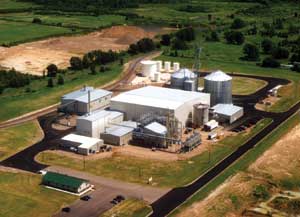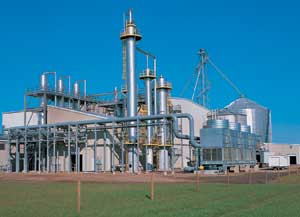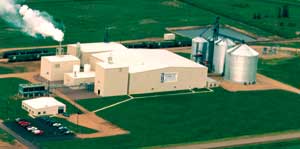Opportunities to Conserve Water







February 9, 2007
BY Holly Jessen
Water is an integral part of the ethanol production process. Although most of it enters an ethanol plant through wells or city utilities, even a small but crucial part comes into the facility in the form of moisture in the corn, which leaves in the ethanol and distillers grains. A typical 50 MMgy corn-based dry-grind ethanol plant uses 3.63 gallons of water for every gallon of ethanol produced, according to Mike Fatigati, vice president of Delta-T Corp.
Fatigati's presentation at BBI International's biofuels workshop Nov. 28 in San Diego, Calif., was entitled "Conserving Water in Ethanol Plants." The presentation examined water used and lost throughout the process, from the cooling tower and boiler to the distillers dried grains dryer/thermal oxidizer.
Despite the 3:1 water-to-ethanol ratio, there are opportunities to improve on the industry's best practice, including reducing energy consumption, recycling waste and blowdown streams, and changing the heat transfer medium. "It's possible today, with a little extra capital cost and available technology, to get that number 3 to about 1.5 [gallons]," Fatigati told the audience. Furthermore, it's conceivable with new technologies to bring that number down to zero by making use of the water that comes in with the corn to drive the process.
Using the scenario of a single hour in the production process of a typical 50 MMgy corn-fed ethanol plant throughout his presentation, Fatigati walked attendees through a step-by-step process of a plant's water use. Every hour, 2,233 bushels of corn are accepted into the plant. At 14 percent moisture, that corn brings with it 2,248 gallons of water, he said, "which means that for every bushel of corn that comes into the plant, we get about a gallon of water attached to that."
A total of 6,631 gallons of fresh makeup water is also brought into the plant hourly. Water from the corn and the fresh makeup water are used in the process and end up in the ethanol and distillers dried grains with solubles (DDGS) at the back end of the process. That breaks down to 5,952 gallons of ethanol an hour containing 18.5 gallons of water at 0.3 percent moisture, and 20.92 tons of DDGS an hour at 10 percent moisture containing 502 gallons of water.
Fatigati compared water coming into the plant in corn at 2,248 gallons an hour with water exiting the plant in its products at 520 gallons an hour. "If we do the sum—the sum of the water in and the water out—we see that it just doesn't add up," he said.
Step By Step
In terms of water supply, the cooling tower—one of an ethanol plant's largest water users—tends to be neglected by inexperienced developers, Fatigati said. He also noted that the numbers quoted for overall water use in an ethanol plant sometimes omit the demands of the cooling tower. "We need to be careful when we talk about this," he said.
There is a certain amount of recirculation of water in the cooling tower, and that rate increases with better water quality. For an example, Fatigati used a recycle rate of 2.5 times, "which is kind of low, but not too unrealistic," he said. "Typically as an industry, we can depend on cycles being anywhere from three to seven, the higher the recycle rate, the less blowdown and the less reject that we have to deal with," he said. Reject is the stream that contains all the concentrated salts and minerals that eventually are collected in an evaporation pond, he explained.
Every hour, a total of 14,700 gallons of makeup water goes into the cooling tower. That water evaporates at a rate of 8,820 gallons per hour, 5,280 gallons is lost to blowdown, and drift accounts for another 600 gallons, Fatigati said.
Water used by the boiler, which provides thermal energy that the plant uses to distill, evaporate and purify ethanol, can also vary depending on water quality. A plant uses 13,860 gallons of water an hour for steam—again based on a 50 MMgy corn-based dry-grind ethanol plant. However, that can be balanced out using Delta-T's no-contact steam system because 10,000 to 13,600 gallons of water from condensation can be reused, Fatigati said. Smaller water users in the boiler are the deaerator and the blowdown, which use 136 gallons and 120 gallons of water an hour respectively.
At the distillers grains dryer/thermal oxidizer process, wet cake is produced at a rate of 111,892 pounds per hour, along with 8,900 gallons of moisture in syrup, Fatigati said. Drying the wet cake releases 8,398 gallons water vapor an hour. A total of 20.92 tons of distillers dried grains can be produced in the hour, containing 502 gallons of water. "Evaporation, again, accounts for the biggest water loss in this particular process," he said.
If one were to connect all the process pieces together, about 23,860 gallons of water would go into the plant every hour and an equal amount of water would come out of the plant. That accounts for all the losses from evaporation, leaks, blowdown and the deaerator, Fatigati said.
Opportunities to Improve
The bottom line is that there are already technologies out there to help reduce water use from the current best practice to a ratio of 1.5 gallons of water to 1 gallon of ethanol. In the future, that could be slimmed down to zero water use, other than moisture coming in with the corn, Fatigati said. Although the technologies can be difficult to implement, there is interest and it's conceivable.
Reducing energy consumption is one of the first opportunities for water conservation in an ethanol plant. One way to do that is to increase the hydraulic efficiency of the process, Fatigati said. Delta-T's dry fractionation technology can help accomplish that by removing some of the inert material that goes through the process and ends up as distillers grains. "By doing so, heat transfer becomes better and water usage is reduced," he said.
Fermentation titer, or the concentration of water in ethanol, can also be increased. By removing less water from the ethanol, a plant is using less water and energy, which has a double whammy impact.
Another option is recycling wastewater and blowdown streams, Fatigati said. This can require a change in the chemistry of the water itself or how the water is treated. This method helps increase the number of cycles that use water.
A more difficult or extreme method to reduce water use is switching from a wet cooling tower to a dry cooling tower. This method would use air or groundwater to reject heat at the cooling tower. "The trade-off there is not only capital expense but operating expense, as well," Fatigati said. "It may make sense in an area where water is at a premium."
Water vapor is a large source of water loss to an ethanol plant, as well. Delta-T is introducing a high-efficiency dryer that decreases both energy needs and water use, he said. It uses low-pressure, super-saturated steam. Fatigati mentioned a dryer of this type being installed in plants in China and Turkey, with plans for usage in the United States.
The current industry standard for most vendors is 34,000 British thermal units (Btus), Fatigati said. Delta-T's high-efficiency dryer can reduce that to below 30,000 Btus. Adding dry fractionation on top of that further cuts per-hour power needs to the "high teens," he said.
There are other technologies that can also be used to reduce power and water needs. "As you see with technology bringing that total thermal requirement for the production of a gallon of ethanol into such a low realm, we suddenly start to see the value of other tools [such as] anaerobic digestion, even gasification, wherein an ethanol plant can become totally self-sufficient," he said. "Hopefully numbers like these will finally silence critics who fail to see the positive energy balance of ethanol."
Liquid phase and gaseous phase membranes are another technology development example. "These will replace the molecular sieve, and probably replace the stripper columns and the rectification columns, with a significant drop-off in energy consumed," Fatigati said.
In the end, clean water means a clean environment. "I think it's good to know that the ethanol industry is doing its part to maintain the quality of our environment," he said.
Holly Jessen is an Ethanol Producer Magazine staff writer. Reach her at hjessen@bbibiofuels.com or (701) 746-8385.
Fatigati's presentation at BBI International's biofuels workshop Nov. 28 in San Diego, Calif., was entitled "Conserving Water in Ethanol Plants." The presentation examined water used and lost throughout the process, from the cooling tower and boiler to the distillers dried grains dryer/thermal oxidizer.
Despite the 3:1 water-to-ethanol ratio, there are opportunities to improve on the industry's best practice, including reducing energy consumption, recycling waste and blowdown streams, and changing the heat transfer medium. "It's possible today, with a little extra capital cost and available technology, to get that number 3 to about 1.5 [gallons]," Fatigati told the audience. Furthermore, it's conceivable with new technologies to bring that number down to zero by making use of the water that comes in with the corn to drive the process.
Using the scenario of a single hour in the production process of a typical 50 MMgy corn-fed ethanol plant throughout his presentation, Fatigati walked attendees through a step-by-step process of a plant's water use. Every hour, 2,233 bushels of corn are accepted into the plant. At 14 percent moisture, that corn brings with it 2,248 gallons of water, he said, "which means that for every bushel of corn that comes into the plant, we get about a gallon of water attached to that."
A total of 6,631 gallons of fresh makeup water is also brought into the plant hourly. Water from the corn and the fresh makeup water are used in the process and end up in the ethanol and distillers dried grains with solubles (DDGS) at the back end of the process. That breaks down to 5,952 gallons of ethanol an hour containing 18.5 gallons of water at 0.3 percent moisture, and 20.92 tons of DDGS an hour at 10 percent moisture containing 502 gallons of water.
Fatigati compared water coming into the plant in corn at 2,248 gallons an hour with water exiting the plant in its products at 520 gallons an hour. "If we do the sum—the sum of the water in and the water out—we see that it just doesn't add up," he said.
Step By Step
In terms of water supply, the cooling tower—one of an ethanol plant's largest water users—tends to be neglected by inexperienced developers, Fatigati said. He also noted that the numbers quoted for overall water use in an ethanol plant sometimes omit the demands of the cooling tower. "We need to be careful when we talk about this," he said.
There is a certain amount of recirculation of water in the cooling tower, and that rate increases with better water quality. For an example, Fatigati used a recycle rate of 2.5 times, "which is kind of low, but not too unrealistic," he said. "Typically as an industry, we can depend on cycles being anywhere from three to seven, the higher the recycle rate, the less blowdown and the less reject that we have to deal with," he said. Reject is the stream that contains all the concentrated salts and minerals that eventually are collected in an evaporation pond, he explained.
Every hour, a total of 14,700 gallons of makeup water goes into the cooling tower. That water evaporates at a rate of 8,820 gallons per hour, 5,280 gallons is lost to blowdown, and drift accounts for another 600 gallons, Fatigati said.
Water used by the boiler, which provides thermal energy that the plant uses to distill, evaporate and purify ethanol, can also vary depending on water quality. A plant uses 13,860 gallons of water an hour for steam—again based on a 50 MMgy corn-based dry-grind ethanol plant. However, that can be balanced out using Delta-T's no-contact steam system because 10,000 to 13,600 gallons of water from condensation can be reused, Fatigati said. Smaller water users in the boiler are the deaerator and the blowdown, which use 136 gallons and 120 gallons of water an hour respectively.
At the distillers grains dryer/thermal oxidizer process, wet cake is produced at a rate of 111,892 pounds per hour, along with 8,900 gallons of moisture in syrup, Fatigati said. Drying the wet cake releases 8,398 gallons water vapor an hour. A total of 20.92 tons of distillers dried grains can be produced in the hour, containing 502 gallons of water. "Evaporation, again, accounts for the biggest water loss in this particular process," he said.
If one were to connect all the process pieces together, about 23,860 gallons of water would go into the plant every hour and an equal amount of water would come out of the plant. That accounts for all the losses from evaporation, leaks, blowdown and the deaerator, Fatigati said.
Opportunities to Improve
The bottom line is that there are already technologies out there to help reduce water use from the current best practice to a ratio of 1.5 gallons of water to 1 gallon of ethanol. In the future, that could be slimmed down to zero water use, other than moisture coming in with the corn, Fatigati said. Although the technologies can be difficult to implement, there is interest and it's conceivable.
Reducing energy consumption is one of the first opportunities for water conservation in an ethanol plant. One way to do that is to increase the hydraulic efficiency of the process, Fatigati said. Delta-T's dry fractionation technology can help accomplish that by removing some of the inert material that goes through the process and ends up as distillers grains. "By doing so, heat transfer becomes better and water usage is reduced," he said.
Fermentation titer, or the concentration of water in ethanol, can also be increased. By removing less water from the ethanol, a plant is using less water and energy, which has a double whammy impact.
Another option is recycling wastewater and blowdown streams, Fatigati said. This can require a change in the chemistry of the water itself or how the water is treated. This method helps increase the number of cycles that use water.
A more difficult or extreme method to reduce water use is switching from a wet cooling tower to a dry cooling tower. This method would use air or groundwater to reject heat at the cooling tower. "The trade-off there is not only capital expense but operating expense, as well," Fatigati said. "It may make sense in an area where water is at a premium."
Water vapor is a large source of water loss to an ethanol plant, as well. Delta-T is introducing a high-efficiency dryer that decreases both energy needs and water use, he said. It uses low-pressure, super-saturated steam. Fatigati mentioned a dryer of this type being installed in plants in China and Turkey, with plans for usage in the United States.
The current industry standard for most vendors is 34,000 British thermal units (Btus), Fatigati said. Delta-T's high-efficiency dryer can reduce that to below 30,000 Btus. Adding dry fractionation on top of that further cuts per-hour power needs to the "high teens," he said.
There are other technologies that can also be used to reduce power and water needs. "As you see with technology bringing that total thermal requirement for the production of a gallon of ethanol into such a low realm, we suddenly start to see the value of other tools [such as] anaerobic digestion, even gasification, wherein an ethanol plant can become totally self-sufficient," he said. "Hopefully numbers like these will finally silence critics who fail to see the positive energy balance of ethanol."
Liquid phase and gaseous phase membranes are another technology development example. "These will replace the molecular sieve, and probably replace the stripper columns and the rectification columns, with a significant drop-off in energy consumed," Fatigati said.
In the end, clean water means a clean environment. "I think it's good to know that the ethanol industry is doing its part to maintain the quality of our environment," he said.
Holly Jessen is an Ethanol Producer Magazine staff writer. Reach her at hjessen@bbibiofuels.com or (701) 746-8385.
Advertisement
Advertisement
Upcoming Events





